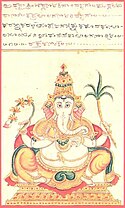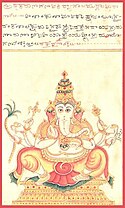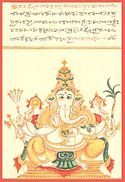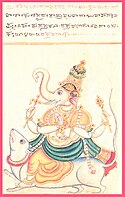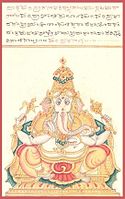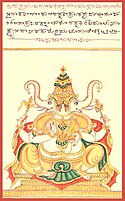Thirty-two forms of Ganesha: Difference between revisions
imported>RAJIVVASUDEV (Importing Wikidata short description: "Verious forms of God Ganesha of Hinduism" (Shortdesc helper)) |
(robot: Update article (please report if you notice any mistake or error in this edit)) |
||
| Line 25: | Line 25: | ||
|- | |- | ||
| [[Bala Ganapati|{{IAST|Bāla Gaṇapati}}]] <br><br><br><br> "Childlike Ganapati" | | [[Bala Ganapati|{{IAST|Bāla Gaṇapati}}]] <br><br><br><br> "Childlike Ganapati" | ||
| [[File:BAlagaNapati1 | | [[File:BAlagaNapati1.jpg|125px]] | ||
| '''tatra bālagaṇapatidhyānaṁ'''<br> | | '''tatra bālagaṇapatidhyānaṁ'''<br> | ||
karasthakadalīcūta <nowiki>|</nowiki> panasekṣucamodakaṁ <nowiki>|</nowiki> bālasūryanibhaṁ vaṁde | karasthakadalīcūta <nowiki>|</nowiki> panasekṣucamodakaṁ <nowiki>|</nowiki> bālasūryanibhaṁ vaṁde | ||
| Line 36: | Line 36: | ||
|- | |- | ||
| {{IAST|Taruṇa Gaṇapati}} <br><br><br><br> "Youthful Ganapati" | | {{IAST|Taruṇa Gaṇapati}} <br><br><br><br> "Youthful Ganapati" | ||
| [[File: | | [[File:Taruṇa Gaṇapati (Sritattvanidhi).jpg|125px]] | ||
|'''{{IAST|atha taruṇagaṇapatidhyānaṁ}} <nowiki>||</nowiki> {{IAST|mudgalapurāṇe}} <nowiki>||</nowiki>'''<br> | |'''{{IAST|atha taruṇagaṇapatidhyānaṁ}} <nowiki>||</nowiki> {{IAST|mudgalapurāṇe}} <nowiki>||</nowiki>'''<br> | ||
{{IAST|pāshāṁkushāpūpakapitthajaṁbū}} <nowiki>|</nowiki><br> | {{IAST|pāshāṁkushāpūpakapitthajaṁbū}} <nowiki>|</nowiki><br> | ||
| Line 195: | Line 195: | ||
|- | |- | ||
| {{IAST|Vijaya Gaṇapati}} <br><br><br><br> "Ganapati the Victorious" | | {{IAST|Vijaya Gaṇapati}} <br><br><br><br> "Ganapati the Victorious" | ||
| [[File:Vijaya gaNapati | | [[File:Vijaya gaNapati.jpg|125px]] | ||
| '''atha vijayagaNapatidhyAnaM <nowiki>||</nowiki>mudgalapurANE <nowiki>||</nowiki>''' | | '''atha vijayagaNapatidhyAnaM <nowiki>||</nowiki>mudgalapurANE <nowiki>||</nowiki>''' | ||
| Line 314: | Line 314: | ||
|- | |- | ||
| {{IAST|Sṝishṭi Gaṇapati}} <br><br><br><br> "Ganapati the Creator", | | {{IAST|Sṝishṭi Gaṇapati}} <br><br><br><br> "Ganapati the Creator", | ||
| [[File:SRuShTi gaNapati | | [[File:SRuShTi gaNapati.jpg|125px]] | ||
| '''atha sRuShTigaNapatidhyAnaM <nowiki>||</nowiki> mudgalapurANE<nowiki>||</nowiki>''' | | '''atha sRuShTigaNapatidhyAnaM <nowiki>||</nowiki> mudgalapurANE<nowiki>||</nowiki>''' | ||
| Line 327: | Line 327: | ||
|- | |- | ||
| {{IAST|Uddaṇḍa Gaṇapati}} <br><br><br><br> "Ganapati the Unchained", | | {{IAST|Uddaṇḍa Gaṇapati}} <br><br><br><br> "Ganapati the Unchained", | ||
|[[File:UddaMDa gaNapati | |[[File:UddaMDa gaNapati.jpg|125px]] | ||
|'''atha uddaMDagaNapatidhyAnaM <nowiki>||</nowiki>mudgalapurANE <nowiki>||</nowiki>''' | |'''atha uddaMDagaNapatidhyAnaM <nowiki>||</nowiki>mudgalapurANE <nowiki>||</nowiki>''' | ||
| Line 340: | Line 340: | ||
|- | |- | ||
| {{IAST|Ṝiṇamochana Gaṇapati}} <br><br><br><br>"Ganapati the liberator from debts" | | {{IAST|Ṝiṇamochana Gaṇapati}} <br><br><br><br>"Ganapati the liberator from debts" | ||
|[[File:RuNamOcana gaNapati | |[[File:RuNamOcana gaNapati.jpg|125px]] | ||
| '''atha RuNamOcanagaNapatidhyAnaM <nowiki>||</nowiki>mudgalapurANE<nowiki>||</nowiki>''' | | '''atha RuNamOcanagaNapatidhyAnaM <nowiki>||</nowiki>mudgalapurANE<nowiki>||</nowiki>''' | ||
| Line 348: | Line 348: | ||
rmudE syAdRuNamOcakaH <nowiki>||25||</nowiki> '''shvEtavarNaH''' | rmudE syAdRuNamOcakaH <nowiki>||25||</nowiki> '''shvEtavarNaH''' | ||
Ganapati seated on a large [[lotus | Ganapati seated on a large [[lotus throne|lotus]] with his Shakti. He removes the impediment. He has four arms. He is white in colour. His first hand show the movement to bestow boons (varada) ; the three others hold the elephant goad, the noose and the bowl of [[sugar]]ed [[rice]] (pâyasapâtra). | ||
<!--___________________________________________26 _____________________________________________ --> | <!--___________________________________________26 _____________________________________________ --> | ||
|- | |- | ||
| {{IAST|Ḍhuṇḍhi Gaṇapati}} <br><br><br><br> "The Ganapati Sought After" | | {{IAST|Ḍhuṇḍhi Gaṇapati}} <br><br><br><br> "The Ganapati Sought After" | ||
| [[File:DhuMDi gaNapati | | [[File:DhuMDi gaNapati.jpg|125px]] | ||
| '''dhuMDigaNapatidhyAnaM <nowiki>||</nowiki> mudgalapurANE <nowiki>||</nowiki>''' | | '''dhuMDigaNapatidhyAnaM <nowiki>||</nowiki> mudgalapurANE <nowiki>||</nowiki>''' | ||
| Line 366: | Line 366: | ||
|- | |- | ||
| {{IAST|Dvimukha Gaṇapati}} <br><br><br><br> "Two-faced Ganapati" | | {{IAST|Dvimukha Gaṇapati}} <br><br><br><br> "Two-faced Ganapati" | ||
|[[File:DvimuKa gaNapati | |[[File:DvimuKa gaNapati.jpg|125px]] | ||
|'''atha dvimuKagaNapatidhyAnaM <nowiki>|</nowiki> mudgalapurANE <nowiki>|</nowiki>''' | |'''atha dvimuKagaNapatidhyAnaM <nowiki>|</nowiki> mudgalapurANE <nowiki>|</nowiki>''' | ||
| Line 379: | Line 379: | ||
|- | |- | ||
| {{IAST|Trimukha Gaṇapati}} <br><br><br><br> "Three-faced Ganapati" | | {{IAST|Trimukha Gaṇapati}} <br><br><br><br> "Three-faced Ganapati" | ||
|[[File:TrimuKa gaNapati | |[[File:TrimuKa gaNapati.jpg|125px]] | ||
| '''atha trimuKagaNapatidhyAnaM <nowiki>|</nowiki> mudgalapurANe <nowiki>|</nowiki> ''' | | '''atha trimuKagaNapatidhyAnaM <nowiki>|</nowiki> mudgalapurANe <nowiki>|</nowiki> ''' | ||
| Line 392: | Line 392: | ||
|- | |- | ||
| {{IAST|Siṇha Gaṇapati}} <br><br><br><br> "The Lion Ganapati". | | {{IAST|Siṇha Gaṇapati}} <br><br><br><br> "The Lion Ganapati". | ||
| [[File:SiMha gaNapati | | [[File:SiMha gaNapati.jpg|125px]] | ||
|'''atha siMhagaNapatidhyAnaM <nowiki>|</nowiki> mudgalapurANE <nowiki>|</nowiki>''' | |'''atha siMhagaNapatidhyAnaM <nowiki>|</nowiki> mudgalapurANE <nowiki>|</nowiki>''' | ||
| Line 406: | Line 406: | ||
|- | |- | ||
| {{IAST|[[Yoga]] Gaṇapati}} <br><br><br><br> "Ganapati the Ascetic". | | {{IAST|[[Yoga]] Gaṇapati}} <br><br><br><br> "Ganapati the Ascetic". | ||
|[[File:YOga gaNapati | |[[File:YOga gaNapati.jpg|125px]] | ||
| '''atha yOgagaNapatidhyAnaM <nowiki>||</nowiki> mudgalapurANe <nowiki>||</nowiki>''' | | '''atha yOgagaNapatidhyAnaM <nowiki>||</nowiki> mudgalapurANe <nowiki>||</nowiki>''' | ||
| Line 419: | Line 419: | ||
|- | |- | ||
| {{IAST|Durga Gaṇapati}} <br><br><br><br> "Ganapati the Invincible" <br /> similar the Goddess [[Durga|Durgâ]]. | | {{IAST|Durga Gaṇapati}} <br><br><br><br> "Ganapati the Invincible" <br /> similar the Goddess [[Durga|Durgâ]]. | ||
|[[File:DurgAgaNa gaNapati | |[[File:DurgAgaNa gaNapati.jpg|125px]] | ||
| '''atha durgAgaNApatidhyAnaM <nowiki>||</nowiki> mudgalapurANE <nowiki>||</nowiki>'''<br> | | '''atha durgAgaNApatidhyAnaM <nowiki>||</nowiki> mudgalapurANE <nowiki>||</nowiki>'''<br> | ||
taptakAMcanasaMkAsha <nowiki>|</nowiki><br> | taptakAMcanasaMkAsha <nowiki>|</nowiki><br> | ||
| Line 435: | Line 435: | ||
|- | |- | ||
| {{IAST|Saṇkaṭahara Gaṇapati}} <br><br><br><br> "Ganapati - Dispeller of Troubles". | | {{IAST|Saṇkaṭahara Gaṇapati}} <br><br><br><br> "Ganapati - Dispeller of Troubles". | ||
|[[File:SaMkaTahara gaNapati | |[[File:SaMkaTahara gaNapati.jpg|125px]] | ||
| '''atha saMkaTaharagaNapatidhyAnaM <nowiki>||</nowiki> mudgalapurANE <nowiki>||</nowiki>''' | | '''atha saMkaTaharagaNapatidhyAnaM <nowiki>||</nowiki> mudgalapurANE <nowiki>||</nowiki>''' | ||
Latest revision as of 02:03, 22 June 2022
Thirty-two forms of Ganesha are mentioned frequently in devotional literature related to the Hindu god Ganesha (Ganapati).[1][2][3] The Ganesha-centric scripture Mudgala Purana is the first to list them.[4]
Detailed descriptions are included in the Shivanidhi portion of the 19th-century Kannada Sritattvanidhi. There are also sculptural representations of these thirty-two forms in the temples at Nanjangud and Chāmarājanagar (both in Mysore district, Karnataka), done about the same time as the paintings were done and also at the direction of the same monarch.[5] Each of the thirty-two illustrations is accompanied by a short Sanskrit meditation verse (dhyānaśloka), written in Kannada script. The meditation verses list the attributes of each form. The text says that these meditation forms are from the Mudgala Purana.
In his review of how the iconographic forms of Ganapati shown in the Sritattvanidhi compare with those known from other sources, Martin-Dubost notes that the Sritattvanidhi is a recent text from South India, and while it includes many of Ganesha's forms that were known at that time in that area it does not describe earlier two-armed forms that existed from the 4th century, nor those with fourteen and twenty arms that appeared in Central India in the 9th and 10th centuries.[6]
Ramachandra Rao says that:
The first sixteen of the forms of Gaṇapati shown [in the Sritattvanidhi] are more popularly worshipped under the name shoḍaśa-gaṇapati. Among them, the thirteenth, viz. Mahāgaṇapati, is especially widely worshipped. There is a tāntrik sect which is devoted to this form. Śakti-gaṇapati, Ucchishṭa-gaṇapati and Lakshmī-gaṇapati are also tāntrik forms, which receive worship which is cultic and esoteric. Heraṃba-gaṇapati is popular in Nepāl.
— [5]
List[edit]
|
Notes[edit]
- ↑ For color reproductions of the 32 Ganapati pictures from the Sri Tattvanidhi see: Rao, pp. vi-ix.
- ↑ For a description of the Ganapati forms based on personal inspection of one of the Mysore originals, see: Martin-Dubost, pp. 120-123, 376.
- ↑ Line drawings of the 32 meditation forms along with the Sanskrit descriptions appearing in the Śrītattvanidhi are given in: Glory of Ganesha (Central Chinmaya Mission Trust: Bombay, 1995), pp. 85-118. The same set of drawings but with some substitutions in order and naming appears in John A. Grimes, Ganapati: Song of the Self, SUNY Series in Religious Studies (State University of New York Press: Albany, 1995) ISBN 0-7914-2440-5.
- ↑ Grimes p. 52
- ↑ 5.0 5.1 Ramachandra Rao, p. vi.
- ↑ Martin-Dubost, p. 120.
- ↑ Chinmayananda, p. 87.
- ↑ Chinmayananda, p. 88.
- ↑ Chinmayananda, p. 89.
- ↑ Chinmayananda, p. 90.
References[edit]
- Chinmayananda, Swami (1987). Glory of Ganesha. Bombay: Central Chinmaya Mission Trust.
- Annals of the Mysore Royal Family , Part II. Mysore: Government Branch Press. 1922.
- Gopal, R.; Prasad, S. Narendra (2004). mummaDi kRuShNarAja oDeyaru - oMdu cAriTrika adhyana ( Mummadi Krsihnaraja Wodeyar- a Historic Study). Karnataka: Directorate of Archeology and Museums.
- Grimes, John A. (1995). Ganapati: Song of the Self. SUNY Series in Religious Studies. Albany: State University of New York Press. pp. 52, 59–60. ISBN 0-7914-2440-5.
- Heras, H. (1972). The Problem of Ganapati. Delhi: Indological Book House.
- Krishan, Yuvraj (1999). Gaņeśa: Unravelling An Enigma. Delhi: Motilal Banarsidass Publishers. ISBN 81-208-1413-4.
- Martin-Dubost, Paul (1997). Gaņeśa: The Enchanter of the Three Worlds. Mumbai: Project for Indian Cultural Studies. ISBN 81-900184-3-4.
- Ramachandra Rao, S. K. (1992). The Compendium on Gaņeśa. Delhi: Sri Satguru Publications. ISBN 81-7030-828-3. Contains color plate reproductions of the 32 Ganapati forms reproduced from the Sri Tattvanidhi.
- Thapan, Anita Raina (1997). Understanding Gaņapati: Insights into the Dynamics of a Cult. New Delhi: Manohar Publishers. ISBN 81-7304-195-4.
- Wodeyar, Mummadi Krsihnaraja (1997). Sritattvanidhi. Oriental Research Institute, University of Mysore.
